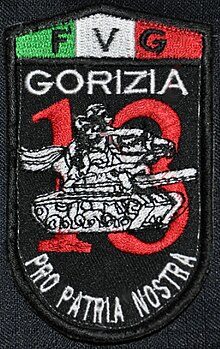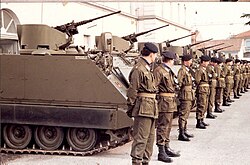13th Carabinieri Regiment "Friuli Venezia Giulia"
| 13th Carabinieri Regiment "Friuli Venezia Giulia" | |
|---|---|
| 13° Reggimento Carabinieri "Friuli Venezia Giulia" | |
 Coat of Arms of the 13th Carabinieri Regiment "Friuli Venezia Giulia" | |
| Active | 1940 - 1943 1947 - present |
| Country | |
| Branch | |
| Type | Gendarmerie |
| Role | Military police, Stability police, Riot control |
| Size | Regiment |
| Part of | 2nd Carabinieri Mobile Brigade |
| Garrison/HQ | Gorizia |
| Motto(s) | "Pro Patria Nostra" |
| Decorations | |
| Commanders | |
| Notable commanders | Gianfrancesco Siazzu |
The 13th Carabinieri Regiment "Friuli Venezia Giulia" (Italian: 13° Reggimento Carabinieri "Friuli Venezia Giulia") is a Regiment of the mobile organization of the Carabinieri, part of the 2nd Carabinieri Mobile Brigade.
The Regiment, based in Gorizia, was established in 2001 from the elevation of the pre-existing Battalion to a higher level, is a mobile unit with a propensity for foreign deployment.
The 13th Carabinieri Regiment “Friuli Venezia Giulia” is made up of three operational companies plus a Command and Services Company. Among the various commanders of the Unit, there was Lieutenant Colonel Gianfrancesco Siazzu, who later became General Commander of the Carabinieri.
History[edit]
Second World War[edit]
On 21 December 1940, the "XIII Mobilized Royal Carabinieri Battalion" was established with personnel drawn from the Carabinieri Territorial Legion of Bologna. The Battalion was deployed on the Albanian front. On 8 September 1943, following the armistice of Cassibile, the Battalion was disbanded.[1][2]
Mobile battalion[edit]
On 5 November 1947, the Mobile Carabinieri Battalion "Gorizia" was established in Padua, under the local Carabinieri Territorial Legion, in order to meet the needs of the eastern border, to contribute to public order and security services and to participate in relief operations for the populations in case of disasters.[1]
On 31 January 1948, the Battalion moved from the capital of Padua to Gorizia and then, on 1 March 1950, assumed the name of "XIII Carabinieri Mobile Battalion" and passed, on the following 1 November, under the control of the Carabinieri Territorial Legion of Udine.[1]
Mechanized battalion[edit]
On 15 October 1964, the Italian Army General Staff arranged for the Battalion to depend on the Army's V Army Corps for training activities (in peacetime) and for operational use in combat zones (in wartime).[3]
On 13 February 1976, the Battalion took on the status of armoured (instead of mechanized) and the name of 13th Carabinieri Battalion "M.O. Gallo". With a Decree of the President of the Republic, on the following 12 November 1976, the War Flag was granted to the Unit.[1][3]
On 1 September 1977, the Battalion became a Corps Command and, on the following 1 December 1977, it came under the control of the 11th Carabinieri Brigade. However, it still remained under the V Army Corps for duties related to wartime use. On 1 February 1978, the Battalion took the name of 13th Carabinieri Battalion "Friuli Venezia Giulia".[1]

On 7 January 1988, the Army General Staff, in the context of the changes to the General Plan for the use of forces in emergencies, ordered the change of dependence of the Battalion from the V Army Corps to the Command of the North-East Military Region.[1]
In the 1990s, following the end of the Cold War and the subsequent modifications of the Italian strategic posture, the 13th Carabinieri Battalion initially lost the tasks and roles of conventional military unit capable of being deployed in a conventional high-intensity scenario and was reassigned to public order duties, in a way akin to duties entrusted to other Carabinieri Battalions and Regiments.[4]
With the development of international peacekeeping and stability operations, the Regiment was chosen, together with the 7th Carabinieri Battalion "Trentino Alto Adige", to function as the expeditionary pawn for missions abroad.[4] Since 1991 units of the battalion began to be used in Italian military missions abroad.[1]
Regimental status[edit]
On 15 September 2001, the 13th Carabinieri Battalion "Friuli Venezia Giulia" was elevated to a Regiment. The Regiment came under the control of the newly established 2nd Carabinieri Mobile Brigade, due to a propensity for foreign employment.[1]
In 2003 the 13th Carabinieri Regiment "Friuli Venezia Giulia" inaugurated the framework of the MSU Task Force operations "Antica Babilonia" in Iraq, hoisting the Italian flag in the "Animal House" base. The "Libeccio" base will be built in that place, the first and only outpost of the Italian Armed Forces in the heart of Nasiriyah. On November 12, 2003, at 10.38 am (local time) in the first wave of the 2003 Nasiriyah bombing, the Libeccio base was attacked and destroyed by a suicide commando. The 13th Regiment paid the highest blood toll, leaving on the field three troops and subofficers dead and three severely injured. However, the reaction of the Carabinieri considerably limited the number of victims.[1]
On 25 May 2012, at 08.50 (local time), the Regiment took another casualty during a mission abroad. In Adraskan, a 107mm rocket killed Carabiniere scelto Manuele Braj and seriously injured two others.[1]
On 22 February 2021, Carabiniere Vittorio Iacovacci, escorting the Italian ambassador Luca Attanasio, fell into an ambush in Congo and died on the line of duty.[1]
Mission[edit]

The 13th Carabinieri Regiment "Friuli Venezia Giulia" participates with its own personnel in operations conducted in international theatres. It is used in integrated territorial defence and in military operations abroad for the maintenance and re-establishment of peace and security. Through the dependent units, the Regiment constitutes the backbone of the Multinational Specialized Unit. In Italy, the Regiment can be used to support public order services.[3]
The Regiment is mainly used in missions abroad, contributing to forming a large part of the contingents for the IPU (Integrated Police Unit) Regiments in Bosnia and Herzegovina, employing military police units for the UNIFIL mission in Lebanon, also operating in Albania, North Macedonia, Haiti, Georgia, Eritrea, Palestine, Chad, Somalia, Libya, Djibouti.[3]
Furthermore, the Regiment provides military police forces and also surveillance and escort teams for some of the Italian embassies present in countries defined as "at risk".[3]
The Regiment has also been employed in public order tasks, providing service in the event of events of national importance such as street demonstrations or football matches, as well as disasters and other critical issues.[3]
Operations[edit]
IPU (Integrated Police Unit)
MSU (Multinational Specialized Unit)
Recruitment and training[edit]

Carabinieri of the 13th Carabinieri Regiment "Friuli Venezia Giulia" are trained through a demanding training course. Aspiring operators attend a course lasting approximately 6 months divided into two phases, with intermediate and final practical and theoretical tests for each module.
The training includes theoretical and practical study of numerous subjects including individual combat training, advanced shooting techniques with various weapons and in various situations, NBCR, CQB, FIBUA, BRICK and RAI.
Furthermore, disciplines essential to training are: Counter IED techniques, topography and orienteering, operational first aid, escorts of personalities in a civilian environment or during military operations (VIPs, military commanders, ambassadors), interdiction and counter-interdiction techniques, patrol movement on foot and using vehicles, crowd control techniques, off-road driving, operational use of ropes (rock and buildings).
At the end of the course, the Carabinieri of the 13th Regiment acquire the qualification of "crisis area operator" and consolidate and increase their skills by carrying out continuous maintenance and updating cycles. Individual training is then further expanded by attending various courses, such as marksman, military instructor of physical education and personal defense, shooting instructor, military police instructor, patrolman, intelligence, and other fields.
An increasing number of the Regiment's Carabinieri are now trained and employed with anti-terrorism tasks, forming highly specialized teams equipped with particular equipment to prevent and deal with this threat quickly and incisively.
Notes and references[edit]
- ^ a b c d e f g h i j k Azzurro, Istituto del Nastro (15 January 2023). "13° REGGIMENTO CARABINIERI "FRIULI-VENEZIAGIULIA" – Istituto del Nastro Azzurro" (in Italian). Retrieved 3 March 2024.
- ^ "Regio Esercito - Carabinieri Reali 4/5". www.regioesercito.it (in Italian). Retrieved 3 March 2024.
- ^ a b c d e f Ranaldo, G. (31 March 2015). "13° REGGIMENTO FRIULI VENEZIA GIULIA". www.dearmas.it (in Italian). Retrieved 3 March 2024.
- ^ a b Ranaldo, G. (31 March 2015). "LA FORZA DEL REPARTO È LA COESIONE, PAROLA DI COMANDANTE!". www.dearmas.it (in Italian). Retrieved 3 March 2024.
